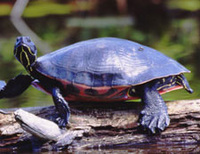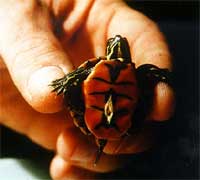Cape Cod had an unusual visitor from the open ocean Wednesday night. A dead leatherback sea turtle weighing several hundred pounds washed ashore at Popponesset Beach in Mashpee, a spokesman for the New England Aquarium said. Tony LaCasse said leatherbacks are an endangered species. This one was 6 to 7 feet across and had been dead for a long time. The body was too decomposed for an necropsy to be performed, he said. A biologist from the University of New Hampshire, which is working with the aquarium and the Massachusetts Audubon Society to research the turtles, took tissue samples and measured the body before it was removed from the beach, LaCasse said. It is unusual for a leatherback to wash ashore on a Massachusetts beach, because they stay in the open water where they feed on jellyfish, he added. Some leatherbacks have been found weighing as much as a ton. Leatherbacks are unusual reptiles, LaCasse said, in that they can shunt blood to their outer extremities. This allows them to travel to colder temperatures than most turtles, as far as the Gulf of Maine and the Canadian sea provinces. ANNE BAKERRare turtle washes up on Cape Cod
![]()

By KATHLEEN D. BAILEY June 24, 2008 EPPING – Chris Bogard cooed to a 20-pound snapping turtle as she lifted the female onto a towel on her kitchen counter. "She's a very pretty girl," Bogard said, "and she's healing very nicely." Good thing, she added, because the snapper is "loaded" with eggs. Bogard, a licensed turtle rehabilitator, isn't always so lucky. Sometimes she can't save the turtles people bring to her, in her private life and at her part-time job at a turtle hospital in Massachusetts. May to July is the prime time for turtles to be out and about -- and to be hit by cars. Bogard has two words for the general public: "Slow down." Article here.
Turtles have a friend in Epping
Special to the Union Leader
Endangered Turtles Get Headstart at Museum
iBerkshires Staff

Over an eight-month period, 10 turtles — known as northern red-bellied cooters — were kept warm and fed in the museum's aquarium section. It's all part of a "headstart" program to help the endangered species thrive in their small pocket of Massachusetts.
"We're really at the very northernmost point of their habitat," said aquarium manager Scott Jervas on Friday, after dropping the cooters off at MassWildlife in Westborough. "We're trying to push the habitat out a little bit."
And that habitat is small — about a dozen ponds in Plymouth County. When the headstart program began in 1984, there were an estimated 300 turtles. Now they number in the low thousands.
Over the past 20 years, some 2,000 of the young reptiles have been fostered and returned to the wild.
The museum joined the program in its early years, said Jervis, and usually brings about 10 of the creatures to the far western corner of the state to spend the winter months in water tub kept at a balmy 86 degrees.
The turtles breed late in the year and lay about 14 eggs; they don't reach reproductive maturity until at least 13 years. The cooters can live up to about 70 years. Their limited habitat (caused in part by human encroachment) within about a dozen small ponds in Plymouth County and their slow movement leaves their young vulnerable to a host of predators. Their small size and high nutritional needs in their formative months also takes a toll on the species' ability to winter over.
Their limited habitat (caused in part by human encroachment) within about a dozen small ponds in Plymouth County and their slow movement leaves their young vulnerable to a host of predators. Their small size and high nutritional needs in their formative months also takes a toll on the species' ability to winter over.
MassWildlife and volunteers literally stake out the nests and scoop the baby turtles up when they hatch to prevent herons, bullfrogs and other predators from snatching them up. They're divvied out to between 15 and 20 zoos, schools, aquariums and volunteers across the state. This year, about 150 were fostered.
"They're constantly supplied with food — primarily romaine lettuce — and have to eat a lot to extract what little nutrition there is," said Jervas, who's been at the museum for 12 years.
What goes in eventually comes out — and a lot of it. The museum tried to care for 16 turtles one year, but that was just too messy, he said.
But all that food translates into rapid growth. "They're about the size of a quarter with a little head and legs when we get them," said Jervas. "They grow to over 2 pounds over the eight or nine months."
The turtles pack on 50 to 70 grams a week and have to be weighed and measured regularly and that falls to the students from Miss Hall's School who are part of an intern program at the museum. By the time the turtles are ready to be released in the spring, they've reached a size that keeps them safe from most predators
They're the second largest freshwater turtle in the state, with adults reaching more than a foot long and weighing up to 10 pounds.
The fostered turtles were returned to MassWildlife on Friday for their final weigh-in; they were released back into the wild on Monday.
Jervas brought his now big turtles to join their cousins and catch up with fellow fostering volunteers at the traditional cookout afterward.
"It's always good to see everyone and compare notes," he said.
TURTLES GONE WILD: In case you missed it live on Monday morning on the shores of Great Quittacas Pond, the Ceremony of the Turtles will begin airing on Friday at 6 p.m. on BTV, Bridgewater’s public access station. The segment will include a Native American blessing of the turtles, which were given a head start by volunteers over the winter, to give them an edge over predators. The simple but moving ceremony, performed by Chief Alden “Windsong” Blake, tribal head of the Assonet tribe of Indians, was a blessing for the Native peoples’ most powerful and sacred animal, the turtle. On Monday, the Division of Fisheries and Wildlife released 137 red-belly cooters into Great Quittacas Pond in Middleboro, and the Comcast crew captured it on film.
Thanks to the efforts of MassWildlife, a small population of endangered turtles in Plymouth County is getting a better chance at survival. In a process called “head-starting,” the state agency division gathered about 150 northern red-bellied cooter hatchlings from the wild last fall and distributed them among 17 caretakers ranging from zoos to high schools. The volunteer caretakers raised the turtles in aquariums over the winter in preparation for their release back into the wild. At MassWildlife’s field headquarters in Westboro on Wednesday, this year’s head-starting graduates were weighed a final time in preparation for their release today into the Great Quittacas and Pocksha ponds in Middleboro, just a few miles from the turtles’ original habitat. Tom French, assistant director of MassWildlife’s Natural Heritage and Endangered Species Program, said the aim of head-starting is to help the hatchlings grow to a size that won’t be gobbled up by other species. Though adult northern red-bellied cooters are the second largest freshwater turtle species in Massachusetts, measuring up to a foot long, they’re only the size of a quarter when they hatch from their eggs. “Everything can eat them,” French said. “They’re easy to find, easy to catch and they usually get eaten up.” Now in its 24th year, MassWildlife’s head-starting project has replenished a turtle population that numbered only 300 across 12 ponds in Plymouth County in the beginning. Were it not for MassWildlife’s intervention, French believes the species, which has more stable populations along the southern East Coast, could have gone extinct in Massachusetts. “They were showing signs they were headed that way,” he said. “Basically, (head-starting) works.” According to French, several of the turtles had already grown to several times the size of their counterparts in the wild, thanks to a winter of steady feeding. “The results are actually quite remarkable,” he said. “Once you get it to this size, nothing can hit it.” Why did the turtle cross the road? ANDOVER — Make way for turtles. That's what the Shawsheen River Watershed Association is trying to get across with new "turtle crossing" signs that will start going up this week around the area. The group is concerned that cars could run over the small shelled creatures. May and June are mating season for turtles, and research shows that turtles are most likely to be run over crossing roads and highways to lay their eggs in ideal sunny, sandy spots. If you see a turtle in the road, the SWRA suggests picking it up and bringing it where it was headed. Don't return it where it was coming from, because it will only make its way into the road again. Contact the SWRA at www.shawsheen.org if you live on a road where turtles cross and would like a sign.Endangered turtles get a head start at life
By Scott O’connell
Mon Jun 02, 2008, 03:41 AM EDT





No comments:
Post a Comment